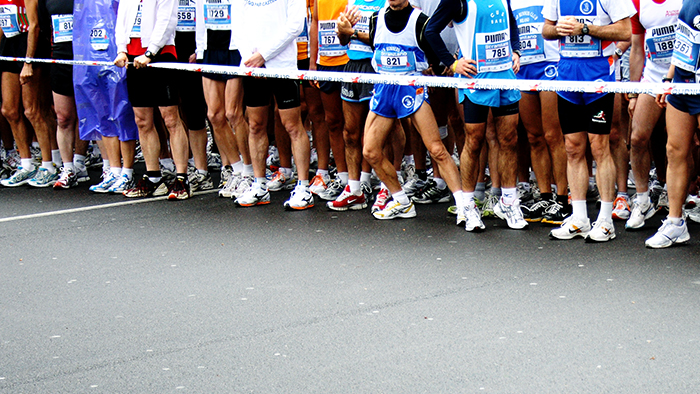We’ve all found ourselves stuck at a race start, teeth chattering, and envying our layered compatriots. That is of course until they find themselves midway through the race trying remove a soaked sweatshirt that has adhered itself to every inch of skin and fabric. That warmth they experienced quickly diminishes and leaves them with regrets for miles to come.
So then how can you warm up for a race like a pro, and manage your temperature along the way? What if you’re stuck at a major race and you didn’t bring a bag for bag check? How do you decide if you should wear a singlet or a t-shirt? We will share a few tips on how to start your race ready to do your best and look your best, so you can run your best into the finish line.
When it comes to race day, the last thing you want to do is sit around shivering. Wearing easily removable layers is key. We recommend tights or running pants with zippers at the ankles for quick removal, and ¼-zip layers up top for the same reason. If you’ve got a long time to wait, or you’re in a situation where shedding pre-start means you might not ever see those layers again, you can do one of two things.
The first is to pack old clothes or second-hand clothes that you’ve pre-cut so you can easily remove them. Many larger races have designated “clothing drop-off” points along the course, and all clothing will be donated post-race to a shelter or other charity.
You can also pack a large trash bag for warmth. You’ve probably seen people do this and thought it was silly—but don’t knock it until you’ve tried it! It’s light and packs down easy and you’re three holes away from a garment that traps heat and keeps you warm and if it’s drizzling—dry!
When it comes to deciding what to wear on race day, stick with the 15-degree rule. Dress for weather that is 15 degrees warmer than the expected high temp during the middle of your race. This allows you stay comfortable for the longest amount of time without overheating.
What about inclement weather? For cold, wet, rainy weather, a tight-fitting and wicking base layer is key. This will help keep warmth close to your body. Loose layers that blow in the wind will pull all the heat away from your body, chilling you.
If it’s extremely wet, a rain shell pulled over a tight base layer will trap more warmth and prevent you from getting soaked with cold rain. You will want to change clothes directly after finishing before your body temperature drops too quickly to avoid a deep chill.
When it comes to layers, there is a veritable cornucopia of choices; cotton, wool, poly, with each company touting why it’s best. Simply put, the best clothing option is one that pulls moisture away from the body and efficiently returns it to the atmosphere.
For your legs, a pair of tights, or ¾ tights (guys and gals—it will change your life!) for the moderately cold days (early or late season races). If you have a big temperature (increasing temps) swing for your big race, it’s best to wear a knit throwaway hat, gloves and arm warmers with a singlet. If you’re wondering what to keep—keep the gloves! There is nothing better than having something to wipe your nose or soak up a little sweat; warm hands never go out of style either.
The most crucial part of staying warm is something you can’t wear but will help you do your best no matter the temp. A good, dynamic warm up is essential to getting your body in a position to race. If you’ve ever said “I didn’t feel like I warmed up until mile two,” you need to do more before you hit the starting line!
You’ll need to elevate your heart rate and get your muscles ready to do their best. This not only helps you run more comfortably earlier, it also helps prevent injury or strain early in the race. If you’re cold, it means your muscles are cold, you wouldn’t jump in your car and run it through every gear with your pedal to the floor—so why do the same with your body?
Start with 10 to 15 minutes of easy running. This jog is to wake up sleepy muscles and just get you a little warm.
Dynamic Warm Up
Movements coupled together follow a down, back sequence over 30 meters
- Butt Kicks, High Knees
- Karaoke (grapevine)
- Skips for Height, Skips for length
- Side Shuffle
- A-Skip, B-Skip
- 2 strides of 60-100m
Finish out by doing a short jog to the start line and either dropping your clothes in the bag checks or making your way into your corral. In an ideal world, you’d get in three to five strides just before you head to the line so that you’re starting with a warm body and a slightly elevated heart rate.
All you trail runners out there, don’t frown on a warm up. While you’re not going to threshold from the gun, you will do a lot of good by warming up your body before your race. The movements detailed above are a great way to get your body moving dynamically and preparing it for the demands that lay ahead.
Trail runners often change the frequency and length of their gate, as well as moving dynamically through turns and over obstacles. Preparing your body for these dynamic movements before you set off is key to a great performance.
Don’t let all of this confuse you; your warm up should be defined by feel. Don’t limit yourself to a specific number of repetitions and hope you’re ready. Start your warm up in what you expect will be your heaviest clothing and as your body rises to racing temperature you will find out just what you need to wear.
If you’re chilled during your warm up, add an article or two until you’re comfortable. This system allows you to stay warm and prepare for a successful event. Start smart, warm up!


